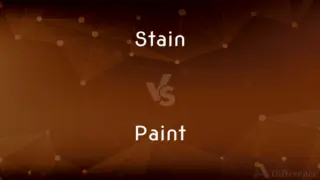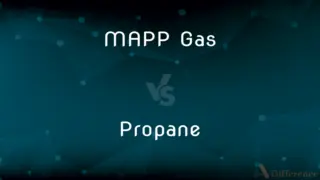Beam vs. Soffit — What's the Difference?
Edited by Tayyaba Rehman — By Urooj Arif — Updated on March 10, 2024
A beam is a structural element that supports loads, typically horizontal, made of wood, steel, or concrete, while a soffit is part of a building's ceiling or roof structure, often covering the underside of eaves.

Difference Between Beam and Soffit
Table of Contents
ADVERTISEMENT
Key Differences
Beams are fundamental components in construction, designed to bear loads and distribute them to supports or foundations, ensuring structural integrity. They span across spaces, providing support for floors, roofs, and ceilings. On the other hand, soffits are architectural features installed on the underside of various structural elements, such as eaves, to conceal and protect them. Soffits can also aid in ventilating attic spaces, preventing moisture buildup and overheating.
While beams are chosen for their strength and material properties, soffits are selected for their aesthetic appeal and functionality in terms of protection and ventilation. Beams are visible in the interior design of some buildings, celebrated for their architectural beauty or hidden within the construction. Conversely, soffits, although primarily functional, are designed to blend seamlessly with the exterior aesthetic, sometimes featuring vents or decorative patterns.
The materials used for beams vary widely, including wood, steel, and concrete, each selected based on the structural requirements, cost, and desired aesthetic. Soffits, however, are made from a variety of materials, including wood, aluminum, vinyl, and fiber cement, chosen for durability, maintenance ease, and appearance.
Installation of beams requires careful planning and consideration of the structural load they will bear, often involving calculations by engineers to ensure safety and stability. Soffit installation, while still important, focuses more on the aesthetic and functional aspects, with considerations for ventilation and moisture control in the design.
The maintenance of beams depends on their material, with wooden beams needing protection from moisture and insects, steel beams from corrosion, and concrete beams from cracks. Soffit maintenance primarily involves ensuring proper ventilation, cleaning, and checking for signs of wear or damage, particularly in materials susceptible to environmental effects.
ADVERTISEMENT
Comparison Chart
Purpose
Supports loads and distributes them across structures
Covers and protects the underside of structural elements
Location
Throughout buildings as part of the structural frame
Underneath eaves, ceilings, or floors
Material
Wood, steel, concrete
Wood, aluminum, vinyl, fiber cement
Functionality
Structural integrity and support
Aesthetic, protection, ventilation
Maintenance
Depends on material (moisture protection, corrosion prevention)
Cleaning, ensuring ventilation, damage inspection
Compare with Definitions
Beam
Maintenance depends on the material.
Steel beams in the factory were treated to prevent corrosion.
Soffit
Maintenance involves cleaning and inspections.
She cleaned the soffit vents annually to maintain airflow.
Beam
A structural element that supports loads horizontally.
The wooden beam across the ceiling supports the floor above.
Soffit
Covers the underside of eaves or structural components.
The soffit under the roof eaves was installed to protect against rain.
Beam
Requires precise engineering to ensure safety.
The engineer calculated the load each beam could support.
Soffit
Aids in attic ventilation.
Vented soffits help prevent heat buildup in the attic during summer.
Beam
Made from various materials like wood, steel, or concrete.
Concrete beams are crucial for the building's structural integrity.
Soffit
Blends with the building's exterior design.
The soffits were painted to match the house's exterior color.
Beam
Can be a key architectural feature.
Exposed beams added a rustic charm to the cabin.
Soffit
Made from materials like aluminum, vinyl, or wood.
Vinyl soffits are popular for their low maintenance and durability.
Beam
A long, sturdy piece of squared timber or metal used to support the roof or floor of a building
There are very fine oak beams in the oldest part of the house
The cottage boasts a wealth of exposed beams
Soffit
A soffit is an exterior or interior architectural feature, generally the horizontal, aloft underside of any construction element. Its archetypal form, sometimes incorporating or implying the projection of beams, is the underside of eaves (to connect a retaining wall to projecting edge(s) of the roof).
Beam
A ray or shaft of light
A beam of light flashed in front of her
The torch beam dimmed perceptibly
Soffit
The underside of an architectural structure such as an arch, a balcony, or overhanging eaves.
Beam
A radiant or good-natured look or smile
A beam of satisfaction
Soffit
The underside of a structural component, such as a beam, arch, staircase, or cornice.
Beam
Transmit (a radio signal or broadcast) in a specified direction
The satellite beamed back radio signals to scientists on Earth
Soffit
(architectural element) The visible underside of an arch, balcony, beam, cornice, staircase, vault or any other architectural element.
Beam
(of a light or light source) shine brightly
The sun's rays beamed down
Soffit
(pipe technology) The top point of the inside open section of a pipe or box conduit.
The elevation of the pipe soffit is 10.4 meters above mean sea level.
Beam
Smile radiantly
She beamed with pleasure
Soffit
The under side of the subordinate parts and members of buildings, such as staircases, entablatures, archways, cornices, or the like. See Illust. of Lintel.
Beam
A squared-off log or a large, oblong piece of timber, metal, or stone used especially as a horizontal support in construction.
Soffit
The underside of a part of a building (such as an arch or overhang or beam etc.)
Beam
A transverse structural member of a ship's frame, used to support a deck and to brace the sides against stress.
Beam
The breadth of a ship at the widest point.
Beam
The side of a ship
Sighted land off the starboard beam.
Beam
(Informal) The widest part of a person's hips
Broad in the beam.
Beam
A steel tube or wooden roller on which the warp is wound in a loom.
Beam
An oscillating lever connected to an engine piston rod and used to transmit power to the crankshaft.
Beam
The bar of a balance from which weighing pans are suspended.
Beam
(Sports) A balance beam.
Beam
The main horizontal bar on a plow to which the share, coulter, and handles are attached.
Beam
One of the main stems of a deer's antlers.
Beam
A ray or shaft of light.
Beam
A concentrated stream of particles or a similar propagation of waves
A beam of protons.
A beam of light.
Beam
A radio beam.
Beam
To radiate light; shine.
Beam
To smile expansively.
Beam
To emit or transmit
Beam a message via satellite.
Beam
To express by means of a radiant smile
He beamed his approval of the new idea.
Beam
Any large piece of timber or iron long in proportion to its thickness, and prepared for use.
Beam
One of the principal horizontal structural members, usually of steel, timber, or concrete, of a building; one of the transverse members of a ship's frame on which the decks are laid — supported at the sides by knees in wooden ships and by stringers in steel ones.
Beam
(nautical) The maximum width of a vessel (note that a vessel with a beam of 15 foot can also be said to be 15 foot abeam).
This ship has more beam than that one.
Beam
(nautical) The direction across a vessel, perpendicular to fore-and-aft.
Beam
The crossbar of a mechanical balance, from the ends of which the scales are suspended.
Beam
The principal stem of the antler of a deer.
Beam
(literary) The pole of a carriage or chariot.
Beam
(textiles) A cylinder of wood, making part of a loom, on which weavers wind the warp before weaving and the cylinder on which the cloth is rolled, as it is woven.
Beam
The straight part or shank of an anchor.
Beam
The central bar of a plow, to which the handles and colter are secured, and to the end of which are attached the oxen or horses that draw it.
Beam
In steam engines, a heavy iron lever having an oscillating motion on a central axis, one end of which is connected with the piston rod from which it receives motion, and the other with the crank of the wheel shaft.
Beam
A ray or collection of approximately parallel rays emitted from the sun or other luminous body.
A beam of light
A beam of energy
Beam
(figuratively) A ray; a gleam.
A beam of hope, or of comfort
Beam
One of the long feathers in the wing of a hawk.
Beam
(music) A horizontal bar which connects the stems of two or more notes to group them and to indicate metric value.
Beam
(railway) An elevated rectangular dirt pile used to cheaply build an elevated portion of a railway.
Beam
(gymnastics) balance beam
Beam
(ambitransitive) To emit beams of light; to shine; to radiate.
To beam forth light
Beam
To smile broadly or especially cheerfully.
Beam
(transitive) To furnish or supply with beams.
Beam
(transitive) To give the appearance of beams to.
Beam
To transmit matter or information via a high-tech wireless mechanism.
Beam me up, Scotty; there's no intelligent life down here.
The injured crewmembers were immediately beamed to sickbay.
Beam
To transmit, especially by direct wireless means such as infrared.
Beam
To stretch something (for example, an animal hide) on a beam.
Beam
To put (something) on a beam.
Beam
To connect (musical notes) with a beam, or thick line, in music notation.
Beam
Any large piece of timber or iron long in proportion to its thickness, and prepared for use.
Beam
One of the principal horizontal timbers of a building or ship.
The beams of a vessel are strong pieces of timber stretching across from side to side to support the decks.
Beam
The width of a vessel; as, one vessel is said to have more beam than another.
Beam
The bar of a balance, from the ends of which the scales are suspended.
The doubtful beam long nods from side to side.
Beam
The principal stem or horn of a stag or other deer, which bears the antlers, or branches.
Beam
The pole of a carriage.
Beam
A cylinder of wood, making part of a loom, on which weavers wind the warp before weaving; also, the cylinder on which the cloth is rolled, as it is woven; one being called the fore beam, the other the back beam.
Beam
The straight part or shank of an anchor.
Beam
The main part of a plow, to which the handles and colter are secured, and to the end of which are attached the oxen or horses that draw it.
Beam
A heavy iron lever having an oscillating motion on a central axis, one end of which is connected with the piston rod from which it receives motion, and the other with the crank of the wheel shaft; - called also working beam or walking beam.
Beam
A ray or collection of parallel rays emitted from the sun or other luminous body; as, a beam of light, or of heat.
How far that little candle throws his beams!
Beam
A ray; a gleam; as, a beam of comfort.
Mercy with her genial beam.
Beam
One of the long feathers in the wing of a hawk; - called also beam feather.
Beam
To send forth; to emit; - followed ordinarily by forth; as, to beam forth light.
Beam
To emit beams of light.
He beamed, the daystar of the rising age.
Beam
A signal transmitted along a narrow path; guides pilots in darkness or bad weather
Beam
Long thick piece of wood or metal or concrete, etc., used in construction
Beam
A column of light (as from a beacon)
Beam
A group of nearly parallel lines of electromagnetic radiation
Beam
(nautical) breadth amidships
Beam
A gymnastic apparatus used by women gymnasts
Beam
Smile radiantly; express joy through one's facial expression
Beam
Emit light; be bright, as of the sun or a light;
The sun shone bright that day
The fire beamed on their faces
Beam
Express with a beaming face or smile;
He beamed his approval
Beam
Broadcast over the airwaves, as in radio or television;
We cannot air this X-rated song
Beam
Especially of the complexion: show a strong bright color, such as red or pink;
Her face glowed when she came out of the sauna
Beam
Experience a feeling of well-being or happiness, as from good health or an intense emotion;
She was beaming with joy
Her face radiated with happiness
Common Curiosities
Why are soffits used in construction?
Soffits are used to cover and protect the underside of structural elements and can also aid in ventilation.
Can beams be made from materials other than wood, steel, or concrete?
While wood, steel, and concrete are most common, beams can also be made from engineered materials like laminated veneer lumber.
What is the main function of a beam?
A beam provides support and distributes loads across structures.
How do soffits contribute to a building's ventilation?
Soffits can have vents that allow air to circulate into attic spaces, helping to control moisture and temperature.
How are beams integrated into a building's design?
Beams can be either exposed as an aesthetic feature or hidden within walls and ceilings, depending on the architectural design.
Is the installation of beams more complex than soffits?
Yes, installing beams involves structural considerations and engineering calculations, making it more complex than soffit installation.
Are soffits necessary for all buildings?
While not strictly necessary for all buildings, soffits are beneficial for protecting structures and aiding in ventilation.
How do soffits protect against environmental damage?
By covering the undersides of eaves and other structures, soffits protect them from water ingress and pests.
Can the material of a beam affect its load-bearing capacity?
Yes, the material significantly affects a beam's strength and load-bearing capacity, with each material offering different properties.
What maintenance is required for soffits?
Soffit maintenance typically involves regular cleaning and inspections for damage or blockages in vents.
Share Your Discovery

Previous Comparison
Rude vs. Crude
Next Comparison
Sport vs. AthleticsAuthor Spotlight
Written by
Urooj ArifUrooj is a skilled content writer at Ask Difference, known for her exceptional ability to simplify complex topics into engaging and informative content. With a passion for research and a flair for clear, concise writing, she consistently delivers articles that resonate with our diverse audience.
Edited by
Tayyaba RehmanTayyaba Rehman is a distinguished writer, currently serving as a primary contributor to askdifference.com. As a researcher in semantics and etymology, Tayyaba's passion for the complexity of languages and their distinctions has found a perfect home on the platform. Tayyaba delves into the intricacies of language, distinguishing between commonly confused words and phrases, thereby providing clarity for readers worldwide.















































